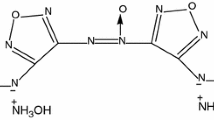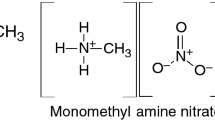Abstract
Context
Since solid composite propellants are composed of a high percentage of oxidizers, the search for green oxidizers such as ammonium dinitramide (ADN) as a substitute for non-eco-friendly ammonium perchlorate (AP) is an important issue. ADN/GAP propellants are good green candidates to replace conventional AP/HTPB propellants. The incompatibility issue of ADN with isocyanate curing agents of polyurethane binders is a well-known problem.
Methods
In this research, from the perspective of molecular dynamics and solubility parameter concept, an attempt was made to study molecular factors determining the preferable curing system for ADN/GAP composite propellants by examining the interaction energy between different isocyanate curing agents and ADN as well as GAP. From another standpoint, the aim is to show that the reactivity rate of different isocyanates with ADN has a significant difference, which has been investigated using molecular dynamics simulation and experimentally. The examined isocyanates include N100, IPDI, TDI, DDI, IPDI/N100, and DDI/N100. The activity of the selected curing system upon ADN was investigated using infrared spectroscopy at different time intervals and compared with the N100 as a conventional curing system. The results show that a meaningful improvement occurs using the selected curing system.
Graphical abstract



Similar content being viewed by others
Data availability
All generated or analyzed data during this study are included in the paper.
Abbreviations
- ADN:
-
Ammonium dinitramide
- AP:
-
Ammonium perchlorate
- CED:
-
Cohesive energy density
- DDI:
-
Dimeryl diisocyanate
- DSC:
-
Differential scanning calorimetry
- Forcite:
-
A module of Materials Studio simulation software
- FOX-12:
-
N-guanylurea-dinitramide
- GAP:
-
Glycidyl azide polymer
- GuDN:
-
N-guanylurea-dinitramide
- HMX:
-
1,3,5,7-Tetranitro-1,3,5,7-tetrazocane
- HTPB:
-
Hydroxyl terminated polybutadiene
- IPDI:
-
Isophorone diisocyanate
- EGA:
-
Evolved gas analysis
- KDN:
-
Potassium dinitramide
- N100:
-
Desmodur® N100
- NPT:
-
Constant number of particles, pressure, and temperature
- NVE:
-
Constant number of particles, volume, and energy
- NVT:
-
Constant number of particles, volume, and temperature
- R :
-
Molar gas constant
- RDX:
-
1,3,5-Trinitroperhydro-1,3,5-triazine
- T :
-
Temperature
- TDI:
-
Toluene diisocyanate
- V m :
-
Molar volume
- ΔH V :
-
Enthalpy of vaporization
References
Ghee AH, Santhosh G (2007) Advances in energetic dinitramides: an emerging class of inorganic oxidizers. World Scientific, Singapore
Trache D, Klapötke TM, Maiz L, Abd-Elghany M, DeLuca T (2017) Recent advances in new oxidizers for solid rocket propulsion. Green Chem 19:711–4736. https://doi.org/10.1039/C7GC01928A
Venkatachalam S, Santhosh G, Ninan KN (2004) An overview on the synthetic routes and properties of ammonium dinitramide (ADN) and other dinitramide salts. Propellants Explos Pyrotech 29:178–187. https://doi.org/10.1002/prep.200400043
Cui JH, Han JY, Wang JG, Huang RS (2010) Study on the crystal structure and hygroscopicity of ammonium dinitramide. J Chem Eng Data 55:3229–3234. https://doi.org/10.1021/je100067n
Bunte G, Neumann H, Antes J, Krause HH (2002) Analysis of ADN, its precursor and possible by-products using ion chromatography. Propellants Explos Pyrotech 27:119–124. https://doi.org/10.1002/1521-4087(200206)27:3%3c119::AID-PREP119%3e3.0.CO;2-T
Landsem E, Jensen TL, Hansen FK, Unneberg E, Kristensen TE (2010) Mechanical properties of smokeless composite rocket propellants based on prilled ammonium dinitramide. Propellants Explos Pyrotech 35:1–8. https://doi.org/10.1002/prep.201200004
Rahm M, Malmström E, Eldsäter C (2011) Design of an ammonium dinitramide compatible polymer matrix. J Appl Polym Sci 122:1–11. https://doi.org/10.1002/app.34186
Keicher T, Kuglstatter W, Eisele S, Wetzel T, Krause H (2009) Isocyanate-free curing of glycidyl azide polymer (GAP) with bis-propargyl-succinate (II). Propellants Explos Pyrotech 34:210–217. https://doi.org/10.1002/prep.200900001
Vo TS, Vo TTBC (2020) Preparation and characterization of bis-propargyl-succinate, and its application in preliminary healing ability of crosslinked polyurethane using “azide-alkyne” click. J Eng Sci Tech Rev 13:110–116
de Flon J, Andreasson S, Liljedahl M, Oscarson C, Wanhatalo M, Wingborg N (2012) Solid propellants based on ADN and HTPB. 47th AIAA/ASME/SAE/ASEE Joint Propulsion Conference & Exhibit. https://doi.org/10.2514/6.2011-6136
Wingborg N, Andreasson S, de Flon J, Johnsson M, Liljedahl M, Oscarson C, Pettersson A, Wanhatalo M (2012) Development of ADN-based minimum smoke propellants. 46th AIAA/ASME/SAE/ASEE Joint Propulsion Conference & Exhibit. https://doi.org/10.2514/6.2010-6586
Wingborg N, de Flon J, Johnson C, Whitlow W (2008) Green propellants based on ADN. Space propulsion 2008, ESA 3AF SNPE
Landsem E, Jensen TL, Kristensen TE, Hansen FK, Benneche T, Unneberg E (2013) Isocyanate-free and dual curing of smokeless composite rocket propellants. Propellants Explos Pyrotech 38:75–86. https://doi.org/10.1002/prep.201200108
Hagen TH, Jensen TL, Unneberg E, Stenstrøm YH, Kristensen TE (2015) Curing of glycidyl azide polymer (GAP) diol using isocyanate, isocyanate-free, synchronous dual, and sequential dual curing systems. Propellants Explos Pyrotech 40:275–284. https://doi.org/10.1002/prep.201400146
Menke K, Heintz T, Schweikert W, Keicher T, Krause H (2009) Formulation and properties of ADN/GAP propellants. Propellants Explos Pyrotech 34:218–230. https://doi.org/10.1002/prep.200900013
Hu J, Tang W, Li Y, He J, Guo X, Rongjie Y (2020) The effect of glycidyl azide polymer grafted tetrafunctional isocyanate on polytriazole polyethylene oxide-tetrahydrofuran elastomer and its propellant properties. Polymers 12:278–289. https://doi.org/10.3390/polym12020278
Wingborg N, Johansson J, Johansson M, Liljedahl M, Lindborg A, Oscarson C, Pettersson Å, Sjöblom M (2013) Solid ADN propellant development. 49th AIAA/ASME/SAE/ASEE Joint Propulsion Conference. https://doi.org/10.2514/6.2013-3723
Lu Q, Chen F, Xiao L, Yang J, Hu Y, Zhang G, Zhao F, Wang Y, Jiang W, Hao G (2022) Advances in the molecular simulation and numerical calculations of the green high-energy oxidant ADN. Mater Today Commun 31:103699. https://doi.org/10.1016/j.mtcomm.2022.103699
Chen F, Xuan C, Lu Q, Xiao L, Yang J, Hu Y, Zhang G, Wang Y, Zhao F, Hao G, Jiang W (2022) A review on the high energy oxidizer ammonium dinitramide: its synthesis, thermal decomposition, hygroscopicity, and application in energetic materials. Def Technol. https://doi.org/10.1016/j.dt.2022.04.006
Lu Q, Xiao L, Wang Y, Zhang G, Hu Y, Chen F, Zhao F, Yang J, Jiang W, Hao G (2022) Theoretical simulation study on crystal property and hygroscopicity of ADN doping with nitramine explosives (RDX, HMX, and CL-20). J Mol Model 28:208. https://doi.org/10.1007/s00894-022-05200-0
Wang F, Liu H, Gong XD (2013) A theoretical study on the structure and hygroscopicity of ammonium dinitramide. Struct Chem 24:1537–1543. https://doi.org/10.1007/s11224-012-0185-x
Ren Z, Chen X, Yu G, Wang Y, Chen B, Zhou Z (2020) Molecular simulation studies on the design of energetic ammonium dinitramide co-crystals for tuning hygroscopicity. CrystEngComm 22:5237–5244. https://doi.org/10.1039/D0CE00602E
Zeng T, Yang R, Li D, Li J, Guo X, Luo P (2020) Reactive molecular dynamics study on the effect of H2O on the thermal decomposition of ammonium dinitramide. Propellants Explos Pyrotech 45:1590–1599. https://doi.org/10.1002/prep.201900309
Chen X, He L, Li X, Zhou Z, Ren Z (2019) Molecular simulation studies on the growth process and properties of ammonium dinitramide crystal. J Phys Chem C 123:10940–10948. https://doi.org/10.1021/acs.jpcc.9b00120
Lan Y, Zhai J, Li D, Yang R (2015) The influence of solution chemistry on the morphology of ammonium dinitramide crystals. J Mater Sci 50:4933–4939. https://doi.org/10.1007/s10853-015-9040-y
Li J, Yang R, Zeng T, Hu J, Tang W, Liu Z, Gong L (2021) Preparation and growth mechanism of micro spherical ammonium dinitramide crystal based on ultrasound-assisted solvent-antisolvent method. Ultrason Sonochem 78:105716. https://doi.org/10.1016/j.ultsonch.2021.105716
Velardez GF, Alavi S, Thompson DL (2003) Molecular dynamics studies of melting and liquid properties of ammonium dinitramide. J Chem Phys 119:6698–6708. https://doi.org/10.1063/1.1605380
Mayo SL, Olafson BD, Goddard WA (1990) DREIDING: a generic force field for molecular simulations. J Phys Chem 94:8897–8909. https://doi.org/10.1021/j100389a010
Hildebrand J, Scott RL (1950) The solubility of nonelectrolytes. Reinhold, New York
Hildebrand J, Scott RL (1962) Regular solutions. Prentice-Hall, Englewood Cliffs, N. J.
Vörde C, Skifs H (2011) Method of producing salts of dinitramidic acid. US 7,981,393 B2
Eroglu MS, Baysa BM, Gueven O (1997) Determination of solubility parameters of poly(epichlorohydrin) and poly(glycidyl azide) networks. Polymer 38:1945–1947. https://doi.org/10.1016/S0032-3861(96)00720-3
Mason JA, Sperling LH (1976) Polymer blends and composites. Plenum Press, New York
Acknowledgements
The author wants to acknowledge the research committee of Malek-Ashtar University of Technology (MUT) for supporting this work.
Author information
Authors and Affiliations
Contributions
Not applicable.
Corresponding author
Ethics declarations
Conflict of interest
The author declares no competing interests.
Additional information
Publisher's note
Springer Nature remains neutral with regard to jurisdictional claims in published maps and institutional affiliations.
Supplementary Information
Below is the link to the electronic supplementary material.
Rights and permissions
Springer Nature or its licensor (e.g. a society or other partner) holds exclusive rights to this article under a publishing agreement with the author(s) or other rightsholder(s); author self-archiving of the accepted manuscript version of this article is solely governed by the terms of such publishing agreement and applicable law.
About this article
Cite this article
Sheibani, N. Simulation and experimental study on the incompatibility issue between ADN and isocyanate. J Mol Model 28, 405 (2022). https://doi.org/10.1007/s00894-022-05399-y
Received:
Accepted:
Published:
DOI: https://doi.org/10.1007/s00894-022-05399-y




